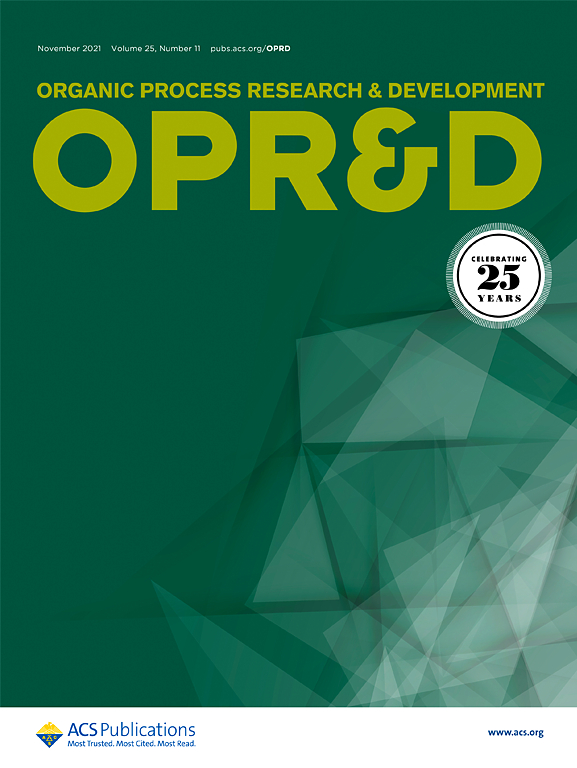辅料和化学品中亚硝酸盐的定量:使用顶空气相色谱-质谱联用技术的多功能高灵敏度方法
IF 3.5
3区 化学
Q2 CHEMISTRY, APPLIED
引用次数: 0
摘要
由于原料药和/或药品中可能存在的仲胺和亚硝酸盐会形成致癌的亚硝胺,因此辅料和化学品中亚硝酸盐的痕量定量是制药行业的主要关注点。这项工作的目的是开发一种亚硝酸盐的定量方法,最低可达到每千克材料 0.05 毫克亚硝酸盐(ppm)的水平,可广泛用于各种辅料和化学品。选择用气相色谱-质谱法检测环己烷与水中的亚硝酸盐反应生成的环己烷,是因为该方法在灵敏度、稳健性、可靠性和特异性方面具有巨大的潜力。为了达到所需的灵敏度,确定并消除了存在明显空白峰的根本原因,该空白峰是关键的限制因素。因此,针对 19 种不同的辅料和化学品,开发并验证了亚硝酸盐定量至 0.05 ppm 目标水平的方法。针对具有挑战性的辅料和化学品(如硬脂酸镁和碳酸盐)开发并成功应用了特定的样品制备方法。结果表明,该方法的定量范围可扩展至 50 ppm,涵盖了很宽的浓度范围。本文章由计算机程序翻译,如有差异,请以英文原文为准。

Quantification of Nitrite in Excipients and Chemicals: A Versatile and Highly Sensitive Method Using Headspace Gas Chromatography Coupled to Mass Spectrometry
The trace level quantification of nitrite in excipients and chemicals is of major interest to the pharmaceutical industry due to the formation of carcinogenic nitrosamines from potentially present secondary amines and nitrite in the API and/or drug product. The aim of this work was the development of a method for the quantification of nitrite down to a level of 0.05 mg nitrite per kg material (ppm) that can be versatilely used for a wide range of excipients and chemicals. The detection of cyclohexene from the reaction of cyclamate with nitrite in water by gas chromatography coupled with mass spectrometry was selected due to its presumed great potential in terms of sensitivity, robustness, reliability, and specificity. The root cause for the presence of a significant blank peak, which was the key limiting factor, was identified and eliminated to achieve the desired sensitivity. Consequently, a method for the quantification of nitrite down to the targeted level of 0.05 ppm was developed and validated for 19 different excipients and chemicals. Specific sample preparation for challenging excipients and chemicals, such as magnesium stearate and carbonates, was developed and successfully applied. It was shown that the quantification range can be expanded up to 50 ppm covering a wide concentration range.
求助全文
通过发布文献求助,成功后即可免费获取论文全文。
去求助
来源期刊
CiteScore
6.90
自引率
14.70%
发文量
251
审稿时长
2 months
期刊介绍:
The journal Organic Process Research & Development serves as a communication tool between industrial chemists and chemists working in universities and research institutes. As such, it reports original work from the broad field of industrial process chemistry but also presents academic results that are relevant, or potentially relevant, to industrial applications. Process chemistry is the science that enables the safe, environmentally benign and ultimately economical manufacturing of organic compounds that are required in larger amounts to help address the needs of society. Consequently, the Journal encompasses every aspect of organic chemistry, including all aspects of catalysis, synthetic methodology development and synthetic strategy exploration, but also includes aspects from analytical and solid-state chemistry and chemical engineering, such as work-up tools,process safety, or flow-chemistry. The goal of development and optimization of chemical reactions and processes is their transfer to a larger scale; original work describing such studies and the actual implementation on scale is highly relevant to the journal. However, studies on new developments from either industry, research institutes or academia that have not yet been demonstrated on scale, but where an industrial utility can be expected and where the study has addressed important prerequisites for a scale-up and has given confidence into the reliability and practicality of the chemistry, also serve the mission of OPR&D as a communication tool between the different contributors to the field.

 求助内容:
求助内容: 应助结果提醒方式:
应助结果提醒方式:


